Did I say the enveloper is The Thing? That was apparently a mistake on my side. The Protein Polymorph is The Thing! (Even though the most famous adaptation with the best looking monster came out a year after this book.) It’s an extremely effective and versatile shapeshifter than can assume the form of pretty much everything. It can blend completely with its surroundings, but usually takes the form of creatures that might attract prey. Being of human-like intelligence, their disguises can be highly devious. It’s only limitation is that it’s very bad at creating facial expressions and can’t really mimic voices, so any kind of interaction with a polymorph in humanoid form quickly reveals that something isn’t right about it. When it imitates inanimate objects, touching it immediately reveals it being some kind of creature. They are pretty tough beasts and also extremely strong, dealing 6d6 damage with their normal attack.
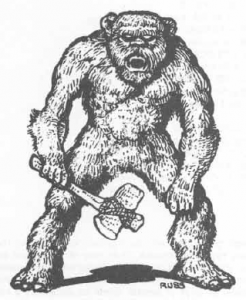
The Quaggoth probably counts as another point on the evil ape counter, but it’s actually a kind of humanoid bear. They are an underground dwelling race that is very primitive and aggressive and attack pretty much anything on sight. Some use stone maces and hammers, while most simply attack with their claws. They are immune to all poisons, which is actually very useful for a race of the underworld. For some reason they have a burning hatred of elves and even willingly serve drow for opportunities to fight them. The creature here is not really that exciting, but I quite like how they got a bit more refined in later editions, so I am showing them here anyway. Some adventure even had crossbreeds of quaggoths and orcs, which I thought were really cool.
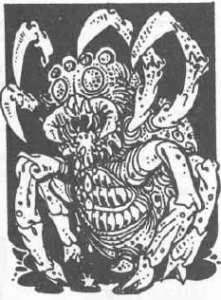
Retrievers are actually a kind of constructs like golems, but they have been created by the demon lord Demogorgon so they are often seen as demons as well. They are used by their demonic master to be send to other planes and kidnap or slay his enemies. A retriever appears like a huge spider with four legs for running and four arms to attack. Its head has six eyes of which only two are for sight and the other four actually to shot magic lasers. Not only do they deal a lot of damage with their four regular attack each round (3d6), the magic rays are outright terrifying. They can shot two of them in the same round, after which they need to recharge for six round. The damage of the fire, lightning, and cold ray is equal to the retrievers hit points, which is on average 45 when uninjured, but could be as high as 80. The fourth ray just turns people to stone instantly. Unsurprisingly, all characters of 5th level or lower have to make a saving throw or flee in panic at the sight of a retriever. I don’t quite now how XP in 1st edition are assigned, but 5,000 is a lot. Oh yeah, and sometimes demons use them to ride into battle.
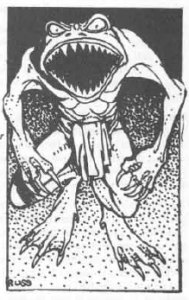
It would be a crime to write about the Fiend Folio without at least mentioning the Slaad. In the Planescape setting, there are not only angels and demons, but similar creatures for all nine alignments. The spot for pure chaos was given to the Slaad. These chaotic neutral creatures are not actually evil, but in practice they never really seemed any different to me from demons and devils. They are still pretty cool though, as they all take the form of big humanoid frogs. They are natives of the plane of Limbo, which is such a pure manifestation of chaos that there isn’t even any stable ground. And yet, of the infinite number of possible shapes beings of pure chaos could appear in, they all take the form of frogs. I think that’s pretty cool. They have their own language but normally communicate with other creatures by telepathy. In this version, all Slaad have a gem with a unique magic symbol on their forehead, and anyone who can get at such a gem can order the slaadi to perform three services for them. Each such gem is unique and can be recognized by all other slaad. There are several kinds of slaad, with the red ones being the weakest. They are pretty basic brawlers but still quite tough ones, and can attempt to teleport other slaad to their help when in danger (as it is common for most demons and devils in D&D). Above them are the greens, blues, and greys, which each get increasingly stronger with more and unusual special abilities. There are only four death slaad, which are a very big step up from the greys, and there are also two Slaad Lords presented in the book. Slaad are weird, a bit goofy, and from the description here I don’t really know what to make of them. With a good idea what to use them for, I think it should not be too difficult to make them interesting enemies.
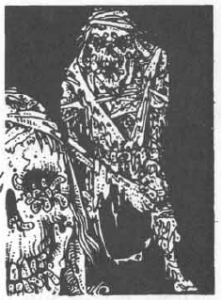
Another classic monster that went on to a long career as a B-List creature. The Son of Kyuss. Kyuss was an evil priests who became a minor god of… I actually have no idea. But he has a huge thing for slimy green worms and a number of beasts he created with that theme. The Son of Kyuss is probably the most notable one, being a corpse infested by a swarm of big green worms. It regenerates two hit points per round and even grows back body parts that have been chopped off. Anything that comes within 10 meters of one have to make a saving throw or flee in panic, which seems a very appropriate ability. Being hit by its fists is obviously not healthy and can infect a creature with leprosy, which will be fatal within a couple of months unless magically healed. In addition, once per round one of the worms will try to bite the target of the sons attack and bury into its body. If not killed and removed within a round, the worm will make its path to the brain and within one to four rounds turn him into another son of kyuss as well.
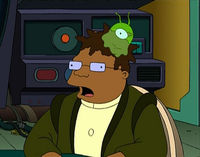
The Symbiotic Jelly seems quite familiar. It has no picture, so I am adding of a brain slug instead. They are basically the same thing anyway. At 70 cm in diameter, it’s somewhat larger and the color is described as green, but by now who wouldn’t go with an apple sized green blob with a big eye instead? The jelly feeds by controlling a dangerous creature which it uses to kill other people or creature that come near its lair and as the prey is eaten, it gets some kind of energy from it. It’s clearly not symbiotic at all, but straight up parasitic, but maybe someone thought it sounds cooler this way. The jelly actually controls its slave from a distance and hides in the shadows on the ceiling of its lair, but where is the fun in that? Brain Slugs!
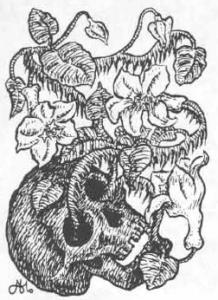
And finally, we got the Yellow Musk Creeper. It’s a kind of vine with yellow flowers which spray a special dust at any creature that gets too close to them. Victims affected by the dust simply walk into the vines to get entangled by them and slowly have its Intelligence drained. When the mind is almost entirely gone, the vines will plant spores into the creature which will cause a new plant to grow from its body, which then takes control over it to protect the original creeper. A usual creeper will have one to two dozen of such living zombies under its control. I really love these ones and have something like them in almost all the campaigns I run.
Fiend Folio Cliche Creature Counter:
- Evil Apes: 2
- Variant Ghouls: 2
- Demon Dogs: 4
- Skeletons with Robes: 5
Fantasy Safari Score:
- Evil Apes: 12
- Variant Ghouls: 6
- Demon Dogs: 6
- Skeletons with Robes: 6
Next up: The Theragraphica for Atlantis: The Second Age.
